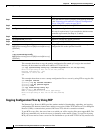
20-15
Cisco IOS Software Configuration Guide for Cisco Aironet Access Points
OL-29225-01
Chapter 20 Managing Firmware and Configurations
Working with Configuration Files
access to a server that supports the remote shell (rsh). (Most UNIX systems support rsh.) Because you
are copying a file from one place to another, you must have read permission on the source file and write
permission on the destination file. If the destination file does not exist, RCP creates it for you.
The RCP requires a client to send a remote username with each RCP request to a server. When you copy
a configuration file from the access point to a server, the Cisco IOS software sends the first valid
username in this list:
• The username specified in the copy command if a username is specified.
• The username set by the ip rcmd remote-username username global configuration command if the
command is configured.
• The remote username associated with the current TTY (terminal) process. For example, if the user
is connected to the router through Telnet and was authenticated through the username command,
the access point software sends the Telnet username as the remote username.
• The access point host name.
For a successful RCP copy request, you must define an account on the network server for the remote
username. If the server has a directory structure, the configuration file is written to or copied from the
directory associated with the remote username on the server. For example, if the configuration file is in
the home directory of a user on the server, specify that user's name as the remote username.
This section includes this information:
• Preparing to Download or Upload a Configuration File by Using RCP, page 20-15
• Downloading a Configuration File by Using RCP, page 20-16
• Uploading a Configuration File by Using RCP, page 20-17
Preparing to Download or Upload a Configuration File by Using RCP
Before you begin downloading or uploading a configuration file by using RCP, perform these tasks:
• Ensure that the workstation acting as the RCP server supports the remote shell (rsh).
• Ensure that the access point has a route to the RCP server. The access point and the server must be
in the same subnetwork if you do not have a router to route traffic between subnets. Check
connectivity to the RCP server by using the ping command.
• If you are accessing the access point through a Telnet session and you do not have a valid username,
make sure that the current RCP username is the one that you want to use for the RCP download. You
can enter the show users privileged EXEC command to view the valid username. If you do not want
to use this username, create a new RCP username by using the ip rcmd remote-username username
global configuration command to be used during all copy operations. The new username is stored in
NVRAM. If you are accessing the access point through a Telnet session and you have a valid
username, this username is used, and you do not need to set the RCP username. Include the username
in the copy command if you want to specify a username for only that copy operation.
• When you upload a file to the RCP server, it must be properly configured to accept the RCP write
request from the user on the access point. For UNIX systems, you must add an entry to the .rhosts
file for the remote user on the RCP server. For example, suppose that the access point contains these
configuration lines:
hostname ap1
ip rcmd remote-username User0
If the access point IP address translates to ap1.company.com, the .rhosts file for User0 on the RCP
server should contain this line:


















